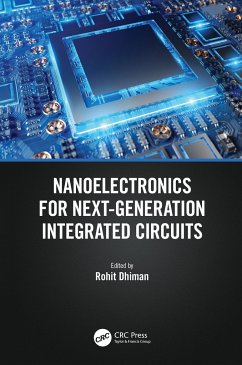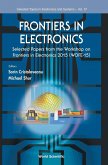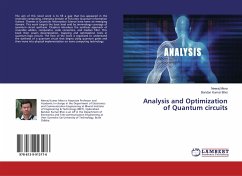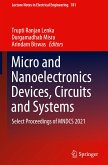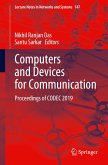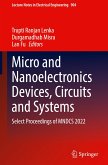Nanoelectronics for Next-Generation Integrated Circuits
Herausgeber: Dhiman, Rohit
Nanoelectronics for Next-Generation Integrated Circuits
Herausgeber: Dhiman, Rohit
- Gebundenes Buch
- Merkliste
- Auf die Merkliste
- Bewerten Bewerten
- Teilen
- Produkt teilen
- Produkterinnerung
- Produkterinnerung
This volume addresses the current state-of-the art in nanoelectronic technologies and presents potential options for next-generation ICs. It will be useful reference guide for researchers, engineers, and advanced students working in the frontier areas of design and modeling of nanoelectronic devices.
Andere Kunden interessierten sich auch für
![Nanoelectronics Nanoelectronics]() Nanoelectronics207,99 €
Nanoelectronics207,99 €![Computer Arithmetics for Nanoelectronics Computer Arithmetics for Nanoelectronics]() Vlad P. ShmerkoComputer Arithmetics for Nanoelectronics311,99 €
Vlad P. ShmerkoComputer Arithmetics for Nanoelectronics311,99 €![FRONTIERS ELECTRONIC (WOFE-15) FRONTIERS ELECTRONIC (WOFE-15)]() Cristoloveanu SorinFRONTIERS ELECTRONIC (WOFE-15)120,99 €
Cristoloveanu SorinFRONTIERS ELECTRONIC (WOFE-15)120,99 €![Analysis and Optimization of Quantum circuits Analysis and Optimization of Quantum circuits]() Neeraj MisraAnalysis and Optimization of Quantum circuits36,99 €
Neeraj MisraAnalysis and Optimization of Quantum circuits36,99 €![Micro and Nanoelectronics Devices, Circuits and Systems Micro and Nanoelectronics Devices, Circuits and Systems]() Micro and Nanoelectronics Devices, Circuits and Systems121,99 €
Micro and Nanoelectronics Devices, Circuits and Systems121,99 €![Computers and Devices for Communication Computers and Devices for Communication]() Computers and Devices for Communication166,99 €
Computers and Devices for Communication166,99 €![Micro and Nanoelectronics Devices, Circuits and Systems Micro and Nanoelectronics Devices, Circuits and Systems]() Micro and Nanoelectronics Devices, Circuits and Systems166,99 €
Micro and Nanoelectronics Devices, Circuits and Systems166,99 €-
-
-
This volume addresses the current state-of-the art in nanoelectronic technologies and presents potential options for next-generation ICs. It will be useful reference guide for researchers, engineers, and advanced students working in the frontier areas of design and modeling of nanoelectronic devices.
Produktdetails
- Produktdetails
- Verlag: CRC Press
- Seitenzahl: 300
- Erscheinungstermin: 23. November 2022
- Englisch
- Abmessung: 240mm x 161mm x 21mm
- Gewicht: 617g
- ISBN-13: 9780367726522
- ISBN-10: 0367726521
- Artikelnr.: 64616207
- Herstellerkennzeichnung
- Libri GmbH
- Europaallee 1
- 36244 Bad Hersfeld
- gpsr@libri.de
- Verlag: CRC Press
- Seitenzahl: 300
- Erscheinungstermin: 23. November 2022
- Englisch
- Abmessung: 240mm x 161mm x 21mm
- Gewicht: 617g
- ISBN-13: 9780367726522
- ISBN-10: 0367726521
- Artikelnr.: 64616207
- Herstellerkennzeichnung
- Libri GmbH
- Europaallee 1
- 36244 Bad Hersfeld
- gpsr@libri.de
Rohit Dhiman received his Bachelor of Technology degree in Electronics & Communication Engineering from HP University Shimla, India in 2007. He did his Master of Technology (M.Tech.) in VLSI Design from National Institute of Technology (NIT) Hamirpur in 2009. He was awarded with the Doctor of Philosophy (Ph.D.) from NIT Hamirpur in 2014. Presently, Dr. Rohit Dhiman is working as an Assistant Professor in Department of Electronics and Communication Engineering at NIT Hamirpur and is the author/co-author of reputed publications in Journals and Conference proceedings of repute. He has been awarded the Young Scientist Award from the Department of Science & Technology, Science and Engineering Research Board, GoI, New Delhi. He has also been bestowed with the prestigious Young Faculty Research Fellowship from the Ministry of Electronics and Information Technology (MeitY), Govt. of India and has three sponsored research projects to his credit. His major research interest is in the device and circuit modeling for low power VLSI design.
1. Emerging Graphene-based Electronics: Properties to Potentials. 2. Models
for Modern Spintronics Memories with Layered Magnetic Interfaces. 3.
Evaluation of Magnetic Anisotropy via Intrinsic Spin Infusion. 4.
Quantum-dot Cellular Automata (QCA) Nanotechnology for the Next Generation
Systems. 5. An Overview of Nanowire Field Effect Transistors For Future
Nanoscale Integrated Circuits. 6. Investigation of Tunnel Field Effect
Transistors (TFETs) for Label Free Biosensing. 7. Analog and Linearity
Analysis of Vertical Nanowire TFET. 8. Effect of Variation in Gate Material
on Enhancement mode P-GaN AlGaN/ GaN HEMT. 9. Electrical Modeling of One
Selector-One resistor (1S-1R) for Mitigating the Sneak. 10. SRAM: An
Essential Part of Integrated Circuits. 11. Implementation of 512bit SRAM
Tile using Lector Technique for Leakage Power Reduction. 12.
Characterization of Stochastic Process Variability Effects on Nano-scale
Analog Circuits. 13. Versatile Single Input Single Output Filter Topology
Suitable for Integrated Circuits. 14. Secured Integrated Circuit (IC/IP)
Design Flow.
for Modern Spintronics Memories with Layered Magnetic Interfaces. 3.
Evaluation of Magnetic Anisotropy via Intrinsic Spin Infusion. 4.
Quantum-dot Cellular Automata (QCA) Nanotechnology for the Next Generation
Systems. 5. An Overview of Nanowire Field Effect Transistors For Future
Nanoscale Integrated Circuits. 6. Investigation of Tunnel Field Effect
Transistors (TFETs) for Label Free Biosensing. 7. Analog and Linearity
Analysis of Vertical Nanowire TFET. 8. Effect of Variation in Gate Material
on Enhancement mode P-GaN AlGaN/ GaN HEMT. 9. Electrical Modeling of One
Selector-One resistor (1S-1R) for Mitigating the Sneak. 10. SRAM: An
Essential Part of Integrated Circuits. 11. Implementation of 512bit SRAM
Tile using Lector Technique for Leakage Power Reduction. 12.
Characterization of Stochastic Process Variability Effects on Nano-scale
Analog Circuits. 13. Versatile Single Input Single Output Filter Topology
Suitable for Integrated Circuits. 14. Secured Integrated Circuit (IC/IP)
Design Flow.
1. Emerging Graphene-based Electronics: Properties to Potentials. 2. Models
for Modern Spintronics Memories with Layered Magnetic Interfaces. 3.
Evaluation of Magnetic Anisotropy via Intrinsic Spin Infusion. 4.
Quantum-dot Cellular Automata (QCA) Nanotechnology for the Next Generation
Systems. 5. An Overview of Nanowire Field Effect Transistors For Future
Nanoscale Integrated Circuits. 6. Investigation of Tunnel Field Effect
Transistors (TFETs) for Label Free Biosensing. 7. Analog and Linearity
Analysis of Vertical Nanowire TFET. 8. Effect of Variation in Gate Material
on Enhancement mode P-GaN AlGaN/ GaN HEMT. 9. Electrical Modeling of One
Selector-One resistor (1S-1R) for Mitigating the Sneak. 10. SRAM: An
Essential Part of Integrated Circuits. 11. Implementation of 512bit SRAM
Tile using Lector Technique for Leakage Power Reduction. 12.
Characterization of Stochastic Process Variability Effects on Nano-scale
Analog Circuits. 13. Versatile Single Input Single Output Filter Topology
Suitable for Integrated Circuits. 14. Secured Integrated Circuit (IC/IP)
Design Flow.
for Modern Spintronics Memories with Layered Magnetic Interfaces. 3.
Evaluation of Magnetic Anisotropy via Intrinsic Spin Infusion. 4.
Quantum-dot Cellular Automata (QCA) Nanotechnology for the Next Generation
Systems. 5. An Overview of Nanowire Field Effect Transistors For Future
Nanoscale Integrated Circuits. 6. Investigation of Tunnel Field Effect
Transistors (TFETs) for Label Free Biosensing. 7. Analog and Linearity
Analysis of Vertical Nanowire TFET. 8. Effect of Variation in Gate Material
on Enhancement mode P-GaN AlGaN/ GaN HEMT. 9. Electrical Modeling of One
Selector-One resistor (1S-1R) for Mitigating the Sneak. 10. SRAM: An
Essential Part of Integrated Circuits. 11. Implementation of 512bit SRAM
Tile using Lector Technique for Leakage Power Reduction. 12.
Characterization of Stochastic Process Variability Effects on Nano-scale
Analog Circuits. 13. Versatile Single Input Single Output Filter Topology
Suitable for Integrated Circuits. 14. Secured Integrated Circuit (IC/IP)
Design Flow.

